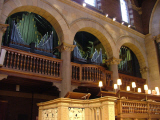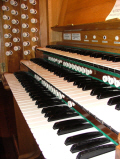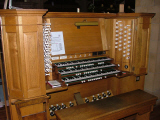The original organ was planned and built between 1919 and 1923, the work of the well-respected local organ builders Stephen Taylor & Son. The organ, together with those in St Peter's, Highfields (1910), and in the De Montfort Hall (1914) were well received and confirmed the firm's reputation beyond Leicestershire.

The Organ Loft
After 40 years of wear the action of the organ was giving serious cause for concern and in 1961 a major reconstruction was carried out by the firm of J. W. Walker & Sons, of Ruislip. Taylor's tubular-pneumatic action was replaced by Walker's then state of the art electro-pneumatic action and the opportunity was taken to make a number of tonal modifications.

The manuals
In 2003, after another 40 years the organ was again in need of major attention. Exposed and dusty contacts which had been making and breaking countless times a minute were now worn out and the wooden parts of the organ, the soundboards and wind chests, had split and were no longer airtight. In addition to restoring the organ to tip-top condition, the opportunity was taken to make some tonal alterations, including the addition of several new stops. This time the work was carried out by Nicholson & Co. of Worcester. Also added around this time was a colour CCTV system which allows the organist to see other musicians at virtually any position around the church.

The Organ console
The restoration of the organ was important to ensure the highest standards in the continuing musical tradition of St James the Greater. But the Church is very much a community building and the organ a community instrument. St James the Greater is also one of Leicester's premier concert venues hosting some 50 concerts every year. Not only does the organ take its place in the Church's services, but is available to the many organisations which regularly use the church, with its fine acoustics, for concert purposes.
The inaugural recital on the new organ was given by Paul Hale, Rector Chori of Southwell Minster, and recitals have since been given by many eminent organists including Carlo Curley, David Briggs and Dame Gillian Weir.
Organ Specification
Following the 2003 rebuild by Nicholsons, the voicing of the instrument is as described below.
- Great Organ: (C-c)
- Double Open Diapason (16)
- Open Diapason I (8)
- Open Diapason II (8)
- Claribel (8)
- Octave (4)
- Gedeckt Flute (4)
- Twelfth (2 2/3)
- Fifteenth (2)
- Sesquialtera 12.17 (II)
- Mixture 22.26.29 (III)
- Scharf 29.33.36 (III)
- Trumpet (8)
- Tremulant
- Swell Organ: (C-c)
- Contra Viol (16)
- Open Diapason (8)
- Stopped Diapason (8)
- Viola (8)
- Vox Angelica (8)
- Principal (4)
- Flauto Traverso (4)
- Fifteenth (2)
- Mixture 19.22.26 (III)
- Hautbois (8)
- Vox Humana (8) - PLANNED
- Double Trumpet (16)
- Trumpet (8)
- Clarion(4)
- Tremulant
- Sub Octave, Unison Off, Octave
- Choir Organ: (C-c)
- Gedeckt (8)
- Dulciana (8)
- Prestant (4)
- Chimney Flute (4)
- Nazard (2 2/3)
- Piccolo (2)
- Tierce (1 3/5)
- Larigot (1 1/3)
- Mixture 15.19.22 (III) - PLANNED
- Clarinet (8)
- Tremulant
- Tuba (8)
- Octave
- Pedal Organ: (C-g 32 notes)
- Sub Bass (32)
- Open Wood (16)
- Open Diapason (16)
- Viol (16)
- Bourdon (16)
- Octave (8)
- Principal (8)
- Bass Flute (8)
- Fifteenth (4)
- Octave Flute (4)
- Mixture 19.22.26.29 (IV)
- Contra Trombone (32) - PLANNED
- Ophicleide (16)
- Trombone (16)
- Trumpet (8)
- Schalmei (4)
Usual pedal and intermanual couplers
